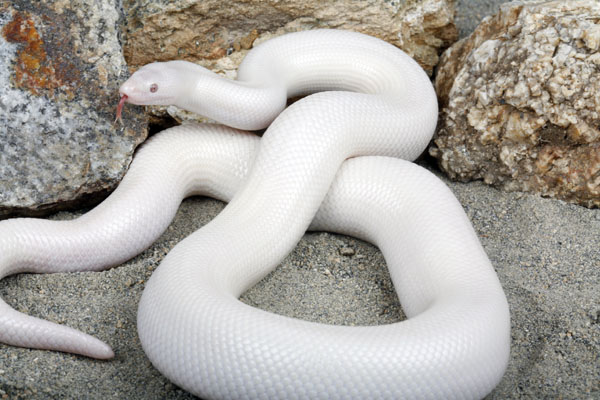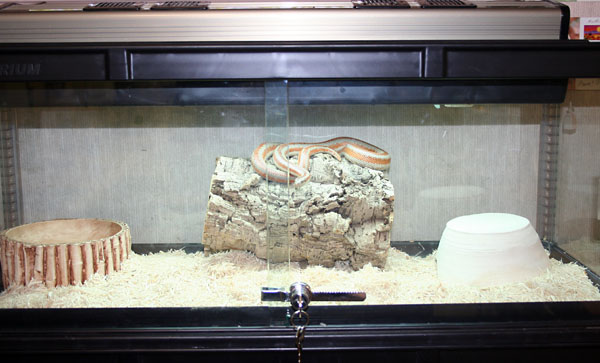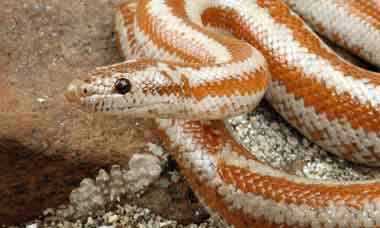Care sheet for the rosy boa (Lichanura trivirgata).
Updated January 30, 2023
Rosy Boa (Lichanura trivirgata)
The rosy boa makes an excellent pet. It is a manageable size, a hardy feeder, easy to breed, and rosy boas are usually very docile and tolerate handling well. With the right snake supplies and keeping reptile health and wellness in mind, this species truly thrives as a beginner pet. By following the tips in this care sheet, you can ensure your rosy boa can live a long, healthy life in captivity. Like many other snake species, rosy boas are also available in a wide array of color patterns and morphs, so there is a rosy boa to suit every hobbyist’s taste!
Rosy Boa Availability
Rosy boas are common at reptile specialty stores, herp shows and on the Internet from private online reptile shops. One can be purchased for as little as $25 (usually for non-locality rosy boas), and prices can go up from there. In general, locality-specific rosy boas cost more because a breeder has taken the time to breed rosy boas found in the same locale. Some rosy boa locality types include the Coastal California, Desert Phase and Mexican rosy boas (the latter including the San Matias Pass and Bay of Los Angeles rosy boas, to name a couple).
Rosy Boa Size
Rosy boas range from 10 inches as hatchlings to almost 4 feet in length when mature. The record length is around 48 inches, although such behemoths are rarely seen, even in captivity. Most rosy boas range from 24 to 36 inches and are perfectly suited for keeping in a 10- or 15-gallon terrarium.

Photo Credit: Gerold Merker
Snow coastal rosy boa.
Rosy Boa Life Span
The rosy boa, given proper care, is a very long-lived snake. One of the authors (R.L.) has had a rosy boa in his collection since the early 1970s. REPTILES magazine columnist Ken Foose had one that passed away in 2011 which had been in captivity since the 1950s. These are the exceptions, though captive rosy boas may be expected to live 30 years or more in captivity.
Rosy Boa Enclosure
Simple caging works exceptionally well when maintaining pet rosy boas. Most importantly, any cage must be escape proof–if a rosy boa finds even the tiniest gap, it will likely escape its enclosure. Cage clips are simple options for screen tops if you must use them. There are many (better) escape-proof enclosures available, and it is prudent to invest in one. Also provide an enclosure that does not have an abrasive top, such as screening, otherwise your snake may need medical attention due to rostral abrasion. Rosy boas are notorious for rubbing their snouts on cage surfaces while looking for ways to escape their enclosures.

Photo Credit: Gerold Merker
Any rosy boa cage must be escape proof, because rosy boas are adept escape artists.
Hatchling rosy boas can be started in deli cups or similarly sized small containers. Adequate ventilation is essential and can easily be achieved by punching small holes in the side or lid of the cup. These holes should not be so large that the snake can push its nose into the hole, which could cause severe abrasions. Enclosure substrate can consist of a small amount of aspen shavings. The enclosure can be placed on heat tape or placed in an incubator. For smaller glass terrariums, heat pads can be used for a temperature gradient. Temperatures should be between 80 and 85 degrees Fahrenheit. It is important to connect heat tapes to a thermostat or a rheostat to maintain the correct temperatures. If the heat tape becomes too hot, the snake may become overheated and a fire hazard can be created.
As your rosy boa grows, so should its enclosure. Medium-sized rosy boas do well in shoebox-sized enclosures. We have kept adults in 10-gallon reptile terrariums for many years with excellent results. These enclosures are easy to clean and are great for setting up thermal regimes that are beneficial to the captive rosy boa. When our rosy boa collection grew in size, we began utilizing a rack system, which is a space saver and works very well in maintaining our colony of rosy boas.
Most snakes are retiring and will appreciate an area in the cage where they can remain hidden from view, so including snake habitat products is never a bad thing for this species. A rosy boa is no exception and will utilize a hide. Whether it’s homemade from a plastic or cardboard container, or store-bought caves, etc., this is a must for new boas. The security provided by a hide also lessens the likelihood that your rosy boa will rub its snout in an attempt to escape the enclosure. We provide two hides: one in the warm region of the cage and one in the cooler area.
Rosy Boa Substrate Recommendations
Rosy boa substrate can be snake beddings such as wood shavings (not too dusty; never cedar), and CareFresh. A depth of 1 to 2 inches of substrate will result in easy maintenance and also allows your snake to burrow, adding to its feelings of security.
Spot clean at least twice weekly and change the entire substrate six or seven times a year using proper reptile cleaning supplies. Dirty substrate may result in the build-up of bacteria, which could be harmful to your rosy boa. A gallon of water mixed with a few tablespoons of soap and a few tablespoons of bleach makes an excellent cleaning solution, or you can use store-bought items like the Zoo Med Wipe Out Terrarium Cleaner and Fluker’s Exo Clean Natural Waste Remover. After using it, rinse the enclosure, the water bowl and the hide(s) with copious amounts of clean water to ensure all the cleanser is removed from the cage. Dry everything and the cage will be ready for a new layer of substrate, followed by your rosy boa.
Rosy Boa Lighting
Snake lighting for rosy boas is not necessary, unless you want to use it to help view your pet. However, one of the most important considerations in rosy boa cage design is the creation of a thermal gradient that will allow your snake to choose from a range of temperatures. The easiest way to accomplish this is by placing heat tape (it is available in various lengths) under one side of the cage. To ensure that the heat tape maintains a constant temperature, a good pulse-proportional thermostat is essential. Pulse-proportional thermostats maintain a constant temperature (plus or minus 1 degree Fahrenheit), thus preventing the cage bottom from becoming overly warm.
A temperature gradient of 65 degrees at the cool end of the enclosure to 90 degrees at the warm end is a good starting place. Adjust the range if you notice your rosy boa is constantly moving about the cage (usually, slightly lower temperatures are needed to stop this restlessness). The warm temperatures can be maintained during spring, summer and fall. A good way to measure this is with a reptile habitat thermometer.
A good strategy for maintaining general health of rosy boas is to allow them to cool down for a few months in winter. This simulates what they would be doing in nature, and it is helpful in establishing a good feeding response in the spring. Reluctant feeders, including hatchlings, often come out of this brumation period with a strong feeding response. Prior to cooling, maintain your rosy boa at its usual temperatures without food for 14 days. This will allow the snake to clear its intestines and stomach. Failure to do so could result in a potentially hazardous situation, as cool temperatures inhibit digestion, and if undigested food is left to spoil in your rosy boa’s gastrointestinal tract during the winter, it could lead to its demise.
After the 14-day fasting period, winter cooling is accomplished by simply turning off the heat tapes and allowing the cage to cool to 55 degrees Fahrenheit. Rosy boas can be cooled in their individual cages to which clean substrate has been added. During brumation, check your snake weekly and provide fresh water. As spring approaches, you can begin raising the temperature back up gradually.
Rosy Boa Food
Rosy boas do great on live reptile food like domesticated mice, and will eat these for their entire lives. A hatchling rosy boa usually starts feeding on fuzzy mice (usually less than 7 days of age), and adults will take small adult mice. It is prudent not to handle your rosy boa too soon after it has eaten; otherwise, it may regurgitate its meal. Feed your rosy boa two to four times monthly during spring, summer and fall. During brumation, do not feed your pet for the reasons mentioned previously.
Occasionally, some rosy boas will not readily feed upon domesticated mice. Several “tricks” can be employed to entice your pet to feed upon this desired food item. A great one is to brumate your rosy boa at 50 to 60 degrees for a month or so. Again, be sure there is no food in the snake prior to lowering the temperature. After a month, slowly warm up the snake. Often, it will feed on a small fuzzy mouse after it’s warmed up.
Rosy Boa Water
Rosy boas do best when they are not provided with a continual water source. We offer ours limited access to water, especially if they are feeding regularly. We usually only provide our rosy boas with water for one day per month. Rosy boas will regurgitate their food if provided with water immediately following a feeding. A better protocol is to offer water for one day, remove the water source, wait a day, and then feed the animal. For hatchlings, a 1-ounce plastic cup stapled to the inside of a hatchling’s container will serve as a non-spilling water dish. For ease of removal, place another 1-ounce plastic cup inside the stapled one. For hatchlings, having water available for one day every three weeks is sufficient under most circumstances.
Rosy Boa Handling and Temperament
A rosy boa is a great subject for gentle handling. If your snake has a strong feeding response, gently nudge it with an inanimate object (such as 12-inch forceps) before reaching into the enclosure to pick it up with your hands. This lets your rosy boa know it is not feeding time.
Let your rosy boa roam about your hands in an unrestrained manner. If you restrain it, your rosy boa will feel uncomfortable and it may try to escape your grasp. Rather than grasping it firmly, always support your rosy boa with both hands so it does not feel threatened.
Gerold Merker, Randy Limburg and Bob Montoya have all been rosy boa enthusiasts since childhood. All three work with numerous rosy boa localities and morphs. For more information, please visit http://www.rosyboainfo.com.



